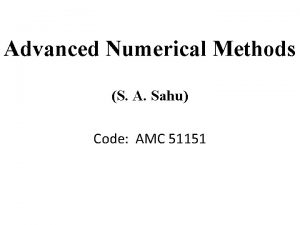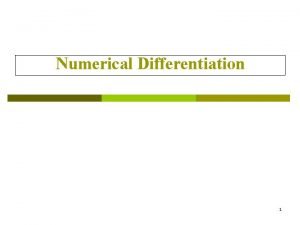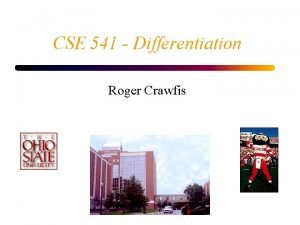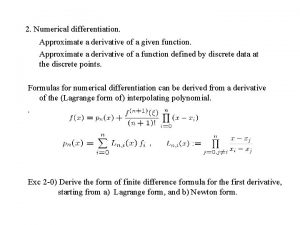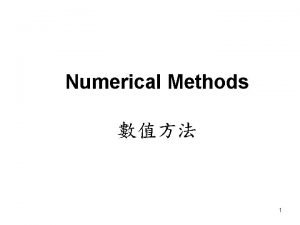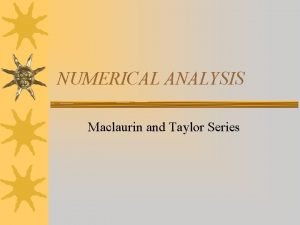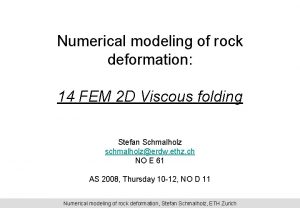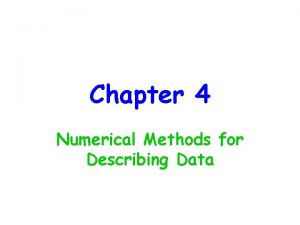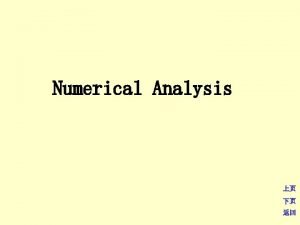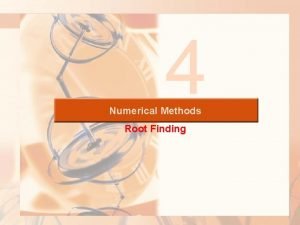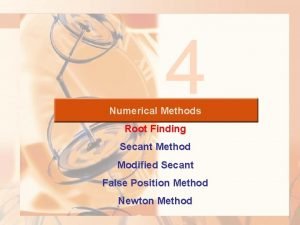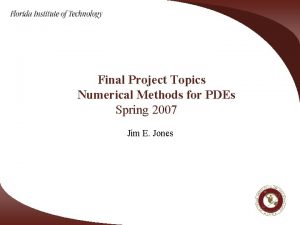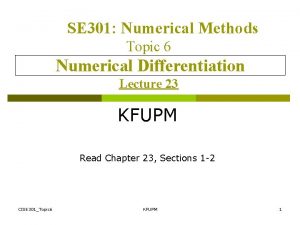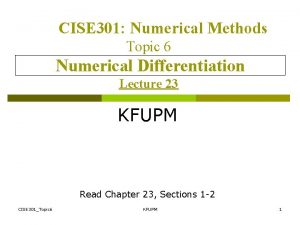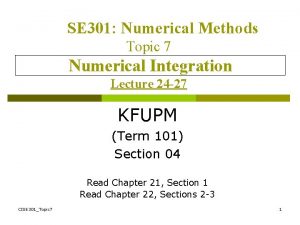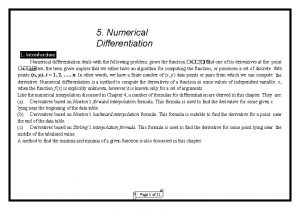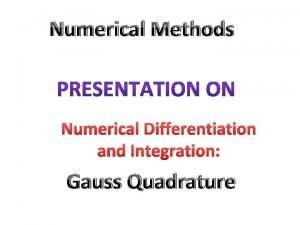SE 301 Numerical Methods Topic 6 Numerical Differentiation






















- Slides: 22

SE 301: Numerical Methods Topic 6 Numerical Differentiation Lecture 23 KFUPM Read Chapter 23, Sections 1 -2 CISE 301_Topic 6 KFUPM 1

Lecture 23 Numerical Differentiation p p CISE 301_Topic 6 First order derivatives High order derivatives Richardson Extrapolation Examples KFUPM 2

Motivation How do you evaluate the derivative of a tabulated function. p How do we determine the velocity and acceleration from tabulated measurements. p CISE 301_Topic 6 KFUPM Time (second) Displacement (meters) 0 30. 1 5 48. 2 10 50. 0 15 40. 2 3

Recall CISE 301_Topic 6 KFUPM 4

Three Formula CISE 301_Topic 6 KFUPM 5

The Three Formulas CISE 301_Topic 6 KFUPM 6

Forward/Backward Difference Formula CISE 301_Topic 6 KFUPM 7

Central Difference Formula CISE 301_Topic 6 KFUPM 8

The Three Formula (Revisited) CISE 301_Topic 6 KFUPM 9

Higher Order Formulas CISE 301_Topic 6 KFUPM 10

Other Higher Order Formulas CISE 301_Topic 6 KFUPM 11

Richardson Extrapolation CISE 301_Topic 6 KFUPM 12

Richardson Extrapolation CISE 301_Topic 6 KFUPM 13

Richardson Extrapolation Table D(0, 0)=Φ(h) D(1, 0)=Φ(h/2) D(1, 1) D(2, 0)=Φ(h/4) D(2, 1) D(2, 2) D(3, 0)=Φ(h/8) D(3, 1) D(3, 2) CISE 301_Topic 6 KFUPM D(3, 3) 14

Richardson Extrapolation Table CISE 301_Topic 6 KFUPM 15

Example 1 CISE 301_Topic 6 KFUPM 16

Example First Column CISE 301_Topic 6 KFUPM 17

Example Richardson Table CISE 301_Topic 6 KFUPM 18

Example Richardson Table 1. 08483 1. 08988 1. 09156 1. 09115 1. 09157 This is the best estimate of the derivative of the function. All entries of the Richardson table are estimates of the derivative of the function. The first column are estimates using the central difference formula with different h. CISE 301_Topic 6 KFUPM 19

Example 2 The measured speed 'V m/sec. ' of a car against time 'T, sec. ' is as shown in the table below: T(s) 2 3 3. 5 4 4. 5 5 6 7 8 V(m/s) 12 10 12 13. 2 14 15 17 16 12 a) Compute the car's acceleration at T=4 sec using the Richardson extrapolation with the best accuracy. b) What is the order of the error of the obtained result in part (a)? CISE 301_Topic 6 KFUPM 20

Solution a) To find the acceleration, we have to differentiate V(4) From the table the max accuracy we can get is D(2, 2) and h=2. First Column D(0, 0) = [f(6)-f(2)]/2(2) = [17 -12]/4 = 1. 25 D(1, 0) = [f(5)-f(3)]/2(1) = [15 -10]/2 = 2. 5 D(2, 0) = [f(4. 5)-f(3. 5)]2/(0. 5) = [14 -12]/1 = 2 Second Column D(1, 1) = (4/3)D(1, 0)-(1/3)D(0, 0) = (4/3)2. 5 – (1/3)1. 25 = 2. 9167 D(2, 1) = (4/3)D(2, 0)-(1/3)D(1, 0) = (4/3)2 – (1/3)2. 5 = 1. 8333 Third Column D(2, 2) = (16/15)D(2, 1)-(1/15)D(1, 1) = (16/15)1. 8333 – (1/15)2. 9167 = 1. 7611 CISE 301_Topic 6 KFUPM 21

Example Richardson Table 1. 25 2. 9167 2 1. 8333 1. 7611 This is the best estimate of the derivative of the function. O(h 2) O(h 4) O(h 6) b) The order is O(h 6). CISE 301_Topic 6 KFUPM 22
 Newton's forward difference formula
Newton's forward difference formula Numerical derivative example
Numerical derivative example Numerical differentiation examples
Numerical differentiation examples Numerical differentiation
Numerical differentiation Numerical differentiation
Numerical differentiation Numerical derivation
Numerical derivation Numerical methods
Numerical methods Taylor series numerical methods
Taylor series numerical methods Numerical methods for partial differential equations eth
Numerical methods for partial differential equations eth Numerical methods for describing data
Numerical methods for describing data Relative true error formula
Relative true error formula Types of errors in numerical analysis
Types of errors in numerical analysis Numerical methods for partial differential equations eth
Numerical methods for partial differential equations eth Descriptive statistics numerical measures
Descriptive statistics numerical measures Graphical and numerical methods
Graphical and numerical methods Interpolation in numerical methods
Interpolation in numerical methods Modified euler's method formula
Modified euler's method formula Fixed point iteration method
Fixed point iteration method Secant method
Secant method Definition of interpolation in numerical analysis
Definition of interpolation in numerical analysis Numerical methods final project
Numerical methods final project What are numerical method in cfd
What are numerical method in cfd Narrow down topic
Narrow down topic
